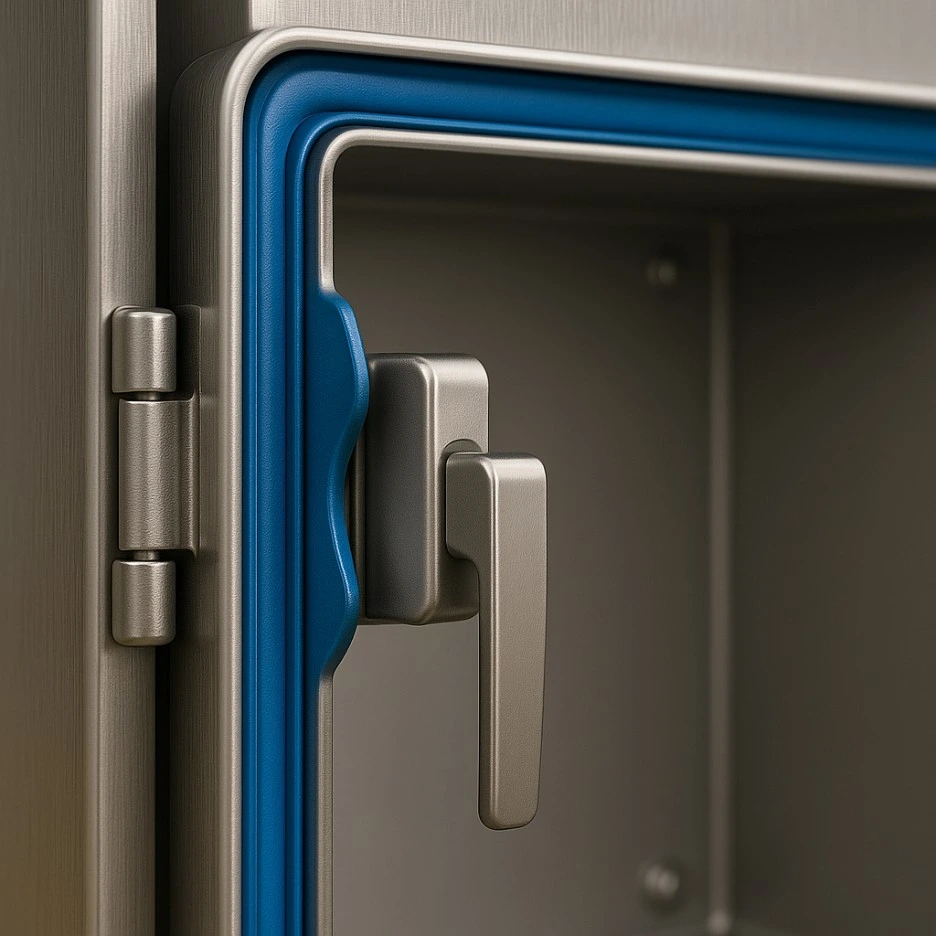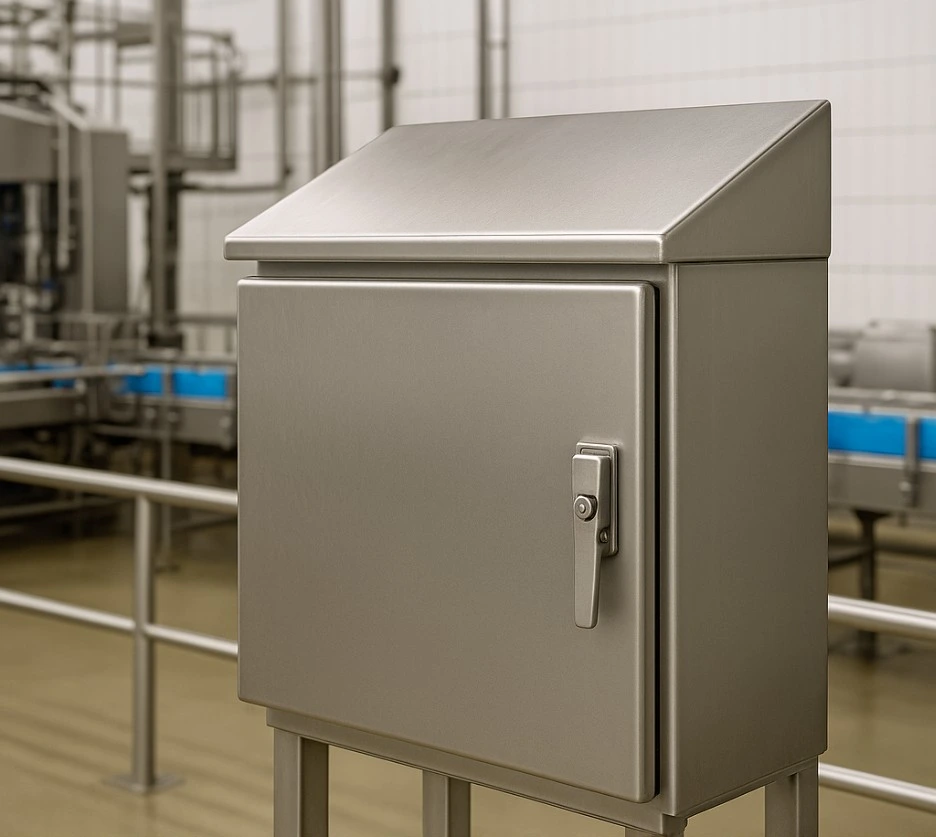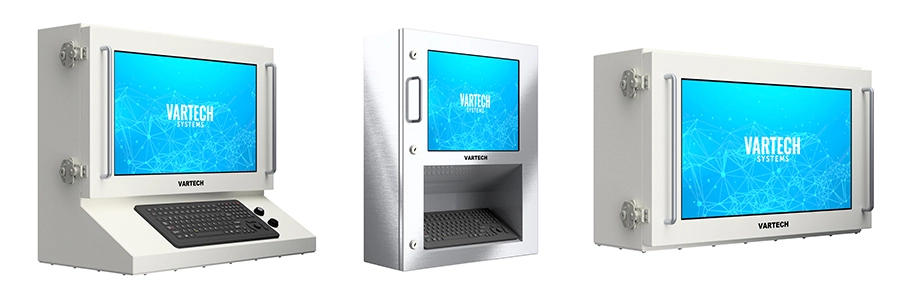
Plant managers, engineers, military procurement teams, and other technical professionals often encounter the challenge of selecting the right enclosure for equipment in demanding environments. Two common standards – NEMA 4 and NEMA 4X – define enclosures that protect electronics from the elements. Both offer robust environmental shielding, but the “X” in NEMA 4X signifies an extra level of defense.
Below, we break down the differences between NEMA 4 and NEMA 4X enclosures in terms of protection levels, corrosion resistance, materials, and typical use cases. The goal is to provide a clear, neutral technical comparison while highlighting why NEMA 4X products are often worth the investment for harsh conditions.
Typical NEMA-rated enclosures are used in industrial applications. NEMA 4 and 4X enclosures both seal out dust and water; NEMA 4X units (often stainless steel, as shown) add robust corrosion resistance.
NEMA (National Electrical Manufacturers Association) assigns type ratings to enclosures to indicate the environments they can withstand. NEMA 4 enclosures and NEMA 4X enclosures are both rated for indoor or outdoor use. They prevent the ingress of solid foreign objects like windblown dust, and they keep out water – even rain, splashing liquids, and hose-directed water.
In other words, equipment housed in either a NEMA 4 or NEMA 4X cabinet is shielded from weather and washdowns. Both types are also built so that external ice formation will not damage them, meaning they can endure freezing conditions. This makes NEMA 4-rated enclosures a workhorse solution for general industrial and outdoor electrical boxes where reliable dustproof and waterproof performance is needed.
The key distinction is that the NEMA 4X rating adds corrosion-resistant qualities. The “X” denotes that the enclosure material or finish can resist rust and corrosion in harsher environments. In all other respects – physical ingress protection and mechanical strength – NEMA 4X meets or exceeds the NEMA 4 criteria.
In practice, many NEMA 4 and 4X enclosures carry similar ingress protection ratings (often roughly equivalent to IP66 in the IEC IP code system, meaning dust-tight and protected against powerful water jets). The added assurance with NEMA 4X is that the enclosure will not readily corrode when exposed to corrosive agents like salt spray, cleaning chemicals, or industrial fumes. NEMA 4 enclosures, while rugged, lack guaranteed rust-proof quality.

Both NEMA 4 and NEMA 4X enclosures are designed to keep the elements out. They feature sealed designs with gaskets and tight-fitting doors or covers that prevent dust and dirt from entering. This is critical in environments like factories, where airborne particles or fibers could interfere with electronics, and in outdoor settings where windblown dust or sand is present.
Likewise, these enclosures are waterproof in common conditions: they protect against rainstorms, sleet, snow, and even direct water jets from a hose (such as during equipment washdowns or fire hose exposure).
In practical terms, a NEMA 4 or 4X enclosure can be hosed down for cleaning and will not allow water to ingress, provided it is properly closed and gasketed. This makes them suitable for washdown areas in food processing or for outdoor control panels that endure rain.

It’s important to note that while they are very water-resistant, NEMA 4/4X units are not intended to be submerged for prolonged periods (submersible enclosures fall under other NEMA types like 6P). However, short-term submersion (e.g. accidental flooding) is sometimes tolerated due to the robust seals – though it’s not guaranteed by the standard.
For most industrial purposes, the protection these enclosures offer against splashing and pressure spraying is more than sufficient. In summary, when it comes to keeping internal components dry and clean, NEMA 4 and 4X are equal, ensuring reliable operation of sensitive equipment in dusty warehouses, outdoor junction boxes, or spray-down factory floors alike.
What separates NEMA 4 and NEMA 4X enclosures is their ability to withstand corrosive environments. This is the critical “X factor” provided by NEMA 4X. A standard NEMA 4 enclosure will typically be made of painted or coated metal (or a basic plastic) that gives it some initial resistance to rust, but it can still corrode over time if the protective coating is scratched or if it’s continuously exposed to corrosive substances.
By contrast, a NEMA 4X enclosure is required to have inherent corrosion protection. In fact, NEMA 4X enclosures must pass a specific corrosion test (often a salt-spray test for a defined number of hours) to ensure they show minimal signs of rust or pitting. This means the materials and finishes used are chosen so that even if the surface is nicked or the enclosure is used in a salt-laden atmosphere, it will resist rusting.

In practical terms, NEMA 4X enclosures are often placed in harsh settings like marine and coastal areas, chemical processing plants, and anywhere there are acidic or salty conditions. For example, in a coastal oil rig or a Navy ship application, saltwater spray can quickly eat through ordinary steel or cause paint to blister and flake. A NEMA 4X cabinet, however, might be built from 316 stainless steel – a material with high nickel and molybdenum content that is extremely resistant to salt corrosion.
Even after years of exposure to sea air, a quality NEMA 4X stainless enclosure will remain largely rust-free. Similarly, in a food and beverage plant, cleaning solutions and sanitizers are used daily; a NEMA 4X (stainless or polymer) enclosure will endure this chemical exposure without corroding, whereas a normal steel box would eventually rust at the joints or scratches.
Simply put, NEMA 4X is engineered for environments where rust is a real danger, providing confidence that the enclosure will protect vital equipment over the long term.
Because of their differing corrosion requirements, NEMA 4 and 4X enclosures often use different materials and finishes. NEMA 4 enclosures are commonly built from mild steel or aluminum with a protective coating. For instance, a powder-coated carbon steel box or an aluminum enclosure with anodization can meet NEMA 4. These materials are durable and cost-effective. They do offer limited corrosion resistance – aluminum naturally doesn’t rust (though it can oxidize) and painted steel will resist rust until the paint is compromised.
Galvanized steel (steel dipped in zinc) is another material sometimes used for NEMA 4, adding a thin sacrificial layer to fend off rust. In non-corrosive indoor settings or general outdoor use, these constructions hold up well. However, if a painted NEMA 4 enclosure gets a deep scratch or is placed in a continuously damp, salty environment, you may eventually see rust form at exposed edges or hardware.
NEMA 4X enclosures, by contrast, are typically made from high-grade stainless steel or corrosion-proof plastics. The most ubiquitous choice is stainless steel (often 304 or 316 stainless steel). Stainless steel contains chromium which forms a passive oxide layer, making it effectively rust-proof under most conditions.
Type 316 stainless steel is preferred for extreme environments due to added elements like molybdenum that fend off chlorides and aggressive chemicals. Many NEMA 4X products are built with a brushed 304/316 stainless steel exterior, including all hinges and latches in stainless steel, so that every part of the enclosure resists corrosion.
Alternatively, non-metallic NEMA 4X enclosures exist, made of materials like fiberglass-reinforced polyester (FRP) or polycarbonate. These polymers are immune to rust and can handle acids and salts without degradation, while also being lighter in weight. They are often used in applications like wastewater plants or coastal installations to avoid any metal corrosion issues altogether.
From a durability standpoint, both NEMA 4 and NEMA 4X enclosures are rugged and designed to protect against impact and weather. The main difference is longevity in corrosive conditions.
A NEMA 4 box might function fine for years in a mild climate but could start to deteriorate if fumes or salt begin to attack its finish. A NEMA 4X unit will last significantly longer under those same harsh conditions, maintaining its structural integrity and seal. For the end user, this translates to less maintenance (no need to frequently repaint or replace rusting boxes) and greater confidence that the enclosure won’t be the point of failure in a critical system.
It’s a pay-now or pay-later choice: invest in better materials up front with NEMA 4X or potentially incur repair/replacement costs down the road if a standard NEMA 4 enclosure succumbs to corrosion.

Deciding between NEMA 4 and NEMA 4X ultimately comes down to the environment and application. Both types are used across industrial, commercial, and military domains, but there are distinct scenarios where one is more appropriate than the other.
If the primary concern is preventing dust and water ingress in a non-corrosive environment, a NEMA 4 enclosure will usually do the job effectively. General outdoor electrical panels and control boxes fall into this category. For example, a factory might use NEMA 4-rated junction boxes on its outdoor equipment skids to protect controls from rain and dirt.
If these boxes aren’t exposed to chemicals or salt, they should perform well. Industrial machinery enclosures inside a plant are another common use – shielding sensitive drives or electronics from dust and occasional water spray (coolant splash or cleaning) without the added cost of stainless steel.
Telecommunications and utility equipment in landlocked or indoor sites might use NEMA 4 cabinets as weatherproof housing for networking gear or metering systems. Even in food processing, certain areas that don’t undergo high-pressure chemical washdowns could use coated steel NEMA 4 enclosures for cost savings, provided any cleaning is gentle and infrequent.
In summary, NEMA 4 is sufficient for environments that are wet or dirty but not chemically aggressive. It offers reliable protection for many everyday industrial situations such as warehouses, standard manufacturing floors, outdoor signage power boxes, and more. Organizations often choose NEMA 4 when budget is tight or when the extra corrosion guard of 4X isn’t deemed necessary by the environmental conditions.
There are many scenarios where the corrosion resistance of NEMA 4X is strongly preferred or even mandated. Marine and Coastal installations are prime examples – any equipment near the ocean (on ships, docks, oil platforms, or coastal facilities) is constantly exposed to saltwater mist and high humidity. In these cases, NEMA 4X enclosures (usually stainless steel) are virtually standard; a regular metal box would rust rapidly.
Chemical processing plants and oil & gas refineries also demand NEMA 4X for certain locations. In these environments, the air itself can carry corrosive vapors (for instance, chlorine, sulfur, acids) that attack metals.
A NEMA 4X enclosure made of 316 stainless or chemical-resistant plastic will protect instrumentation and control systems from these fumes over the long haul. Another important use case is the food and beverage industry, especially in washdown areas. Here, equipment is frequently doused with water and sanitizing chemicals.
Stainless steel NEMA 4X enclosures are the norm for housing on production lines, because they can handle daily high-pressure cleaning without corroding or contaminating the food area. Similarly, pharmaceutical and medical manufacturing settings often use NEMA 4X stainless enclosures to maintain strict hygiene and avoid painting chips or rust near products.
Beyond industry, military and defense applications often favor NEMA 4X-classified hardware for critical field equipment. For instance, a radar unit or communication system deployed in a desert or coastal battlefield will likely be built into a NEMA 4X enclosure to ensure it endures sand, dust, rain, and salt fog.
The extra ruggedness gives military procurement teams confidence that the gear will remain operational with minimal maintenance, even in harsh climates.
Other scenarios strongly calling for NEMA 4X include wastewater treatment plants (which have corrosive gases like hydrogen sulfide), car washes (constant spraying of water with detergent and sometimes recycled water full of minerals), and pulp/paper mills (where chemicals and moisture are abundant).
In all these cases, opting for NEMA 4X is a matter of risk management – it prevents premature failure of electrical enclosures, thereby protecting the expensive components inside and avoiding unplanned downtime. When the environment is unforgiving, the consensus in technical circles is clear: invest in NEMA 4X enclosures to ensure long-term reliability.
One practical consideration when comparing NEMA 4 vs NEMA 4X is cost. Because NEMA 4X enclosures use premium materials (like stainless steel or specialized polymers) and must pass stricter corrosion tests, they generally come at a higher price point than equivalent NEMA 4 versions. For example, a painted NEMA 4 junction box will typically be less expensive than a same-size NEMA 4X box made of 316 stainless steel.
For budget-conscious projects in benign environments, this cost difference can be significant. It would not be wise to pay extra for a NEMA 4X unit if the enclosure is only ever going to see a dry indoor setting with no corrosive threats. In such cases, NEMA 4 is the economical choice that covers all the necessary protection without over specifying.
That said, it’s also important to consider the total cost of ownership and the potential risks. If an application even has a chance of encountering corrosive conditions, the upfront savings of choosing NEMA 4 can evaporate quickly if that enclosure fails prematurely. A rusting enclosure can lead to water ingress, electronic failures, safety hazards, and the need to replace the entire box (and possibly the equipment inside).
The downtime and maintenance costs might far exceed the initial cost difference. Thus, many engineers take a conservative approach: when in doubt, choose NEMA 4X.
The investment in corrosion-proof construction acts as an insurance policy for your equipment. It ensures that no matter how the environment changes or if cleaning procedures become more aggressive, the enclosures will hold up.
In environments that start out mild but could become more corrosive (for instance, a facility considering switching to harsher cleaning agents or a site that may eventually be exposed to salt from winter road treatments), specifying NEMA 4X from the beginning is a forward-thinking decision. The slight premium in cost yields peace of mind and longevity.
Leading enclosure manufacturers and solution providers have recognized the advantages of NEMA 4X and incorporated this level of protection into their rugged product lines.
For example, VarTech Systems offers a range of fully sealed industrial computers, monitors, and HMI workstations that meet NEMA 4X standards. These products are built with stainless steel enclosures and IP66-rated seals, ensuring they are not only dust-tight and rainproof but also resistant to corrosion from cleaning chemicals or marine environments. In practice, this means a VarTech ToughStation display, or computer can be deployed on a food processing line or on an offshore oil platform with equal confidence.

The enclosure will withstand high-pressure washdowns, salt spray, and temperature extremes without compromising the electronics inside. For technical buyers – whether in a manufacturing plant or a military shipyard – this translates to solutions that maintain functionality in the field and require minimal protective maintenance.
VarTech Systems’ adoption of NEMA 4X in its designs highlights a broader industry trend: demand for reliability in harsh environments is on the rise. As operations become more automated and equipment is expected to run 24/7 in all conditions, the tolerance for failures due to environmental exposure is low.
By choosing products and enclosures that carry the NEMA 4X rating, companies and agencies are effectively hardening their systems against one of the most common failure modes (corrosion and water ingress). It’s a persuasive point for anyone concerned with long-term performance.
While a NEMA 4-rated device might meet basic requirements, a NEMA 4X-rated device provides an extra margin of safety and durability. In critical applications – whether a factory production line, a wastewater control system, or a piece of military hardware – that extra margin can make the difference between continuous operation and an unexpected shutdown.
In summary, NEMA 4 and NEMA 4X enclosures are both essential in the toolkit of protective solutions for electronic equipment.
NEMA 4 enclosures deliver robust protection against dust and water, making them suitable for many industrial and outdoor uses where corrosive elements are not present. They are a solid choice for general-purpose durability and often strike a good balance between protection and cost. However, when the environment turns aggressive – think salt, chemicals, constant moisture, or stringent sanitation processes – NEMA 4X stands out as the preferred choice.
The added corrosion resistance ensures that the enclosure remains a reliable guardian of your equipment over the long haul. Technical audiences understand that specifying the correct enclosure up front is far better than dealing with corrosion problems later.
For organizations looking to safeguard their operations, the advice is clear: match the enclosure to the environment. Use NEMA 4 where it suffices, and don’t hesitate to step up to NEMA 4X where longevity and resilience are critical. The slightly higher initial investment in NEMA 4X enclosures or devices pays off long term by preventing damage, downtime, and replacements.
Whether you are an engineer designing a control system for a factory, a plant manager equipping a new facility, or a military procurement officer sourcing field equipment, making an informed choice between NEMA 4 vs NEMA 4X will ensure your technology is protected.
With offerings from reputable providers like VarTech Systems that emphasize NEMA 4X ruggedness, it has never been easier to adopt solutions that thrive in harsh environments. In the end, choosing the right enclosure standard instills confidence that your critical systems will remain secure, operational, and rust-free no matter what mother nature (or an industrial process) throws at them.
At VarTech Systems, our Project Managers—with an average of 15+ years of industry experience—are ready to customize a computer, monitor, or HMI workstation solution to meet your needs. Drawing from extensive backgrounds in manufacturing, military, oil and gas, and marine applications, they provide expert guidance throughout your project journey.
Please fill out our contact form, call us, or email us and we will connect with you shortly.

Based in Clemmons, North Carolina, VarTech Systems Inc. engineers and builds custom industrial and rugged computers, monitors, and HMIs.